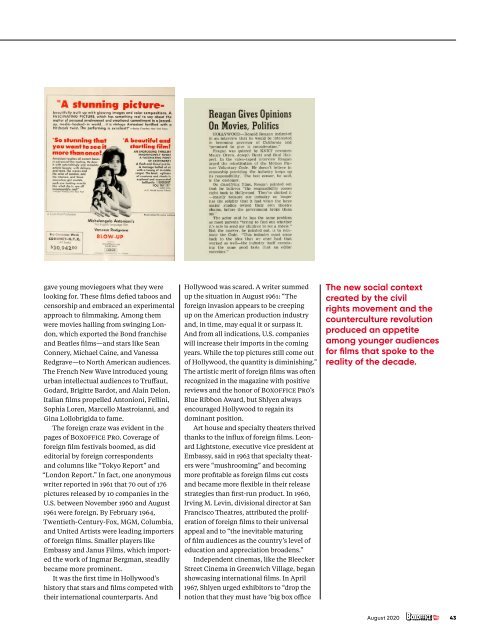Boxoffice Pro - August 2020
The Official Magazine of the National Association of Theatre Owners
The Official Magazine of the National Association of Theatre Owners
- No tags were found...
Create successful ePaper yourself
Turn your PDF publications into a flip-book with our unique Google optimized e-Paper software.
gave young moviegoers what they were<br />
looking for. These films defied taboos and<br />
censorship and embraced an experimental<br />
approach to filmmaking. Among them<br />
were movies hailing from swinging London,<br />
which exported the Bond franchise<br />
and Beatles films—and stars like Sean<br />
Connery, Michael Caine, and Vanessa<br />
Redgrave—to North American audiences.<br />
The French New Wave introduced young<br />
urban intellectual audiences to Truffaut,<br />
Godard, Brigitte Bardot, and Alain Delon.<br />
Italian films propelled Antonioni, Fellini,<br />
Sophia Loren, Marcello Mastroianni, and<br />
Gina Lollobrigida to fame.<br />
The foreign craze was evident in the<br />
pages of <strong>Boxoffice</strong> <strong>Pro</strong>. Coverage of<br />
foreign film festivals boomed, as did<br />
editorial by foreign correspondents<br />
and columns like “Tokyo Report” and<br />
“London Report.” In fact, one anonymous<br />
writer reported in 1961 that 70 out of 176<br />
pictures released by 10 companies in the<br />
U.S. between November 1960 and <strong>August</strong><br />
1961 were foreign. By February 1964,<br />
Twentieth-Century-Fox, MGM, Columbia,<br />
and United Artists were leading importers<br />
of foreign films. Smaller players like<br />
Embassy and Janus Films, which imported<br />
the work of Ingmar Bergman, steadily<br />
became more prominent.<br />
It was the first time in Hollywood’s<br />
history that stars and films competed with<br />
their international counterparts. And<br />
Hollywood was scared. A writer summed<br />
up the situation in <strong>August</strong> 1961: “The<br />
foreign invasion appears to be creeping<br />
up on the American production industry<br />
and, in time, may equal it or surpass it.<br />
And from all indications, U.S. companies<br />
will increase their imports in the coming<br />
years. While the top pictures still come out<br />
of Hollywood, the quantity is diminishing.”<br />
The artistic merit of foreign films was often<br />
recognized in the magazine with positive<br />
reviews and the honor of <strong>Boxoffice</strong> <strong>Pro</strong>’s<br />
Blue Ribbon Award, but Shlyen always<br />
encouraged Hollywood to regain its<br />
dominant position.<br />
Art house and specialty theaters thrived<br />
thanks to the influx of foreign films. Leonard<br />
Lightstone, executive vice president at<br />
Embassy, said in 1963 that specialty theaters<br />
were “mushrooming” and becoming<br />
more profitable as foreign films cut costs<br />
and became more flexible in their release<br />
strategies than first-run product. In 1960,<br />
Irving M. Levin, divisional director at San<br />
Francisco Theatres, attributed the proliferation<br />
of foreign films to their universal<br />
appeal and to “the inevitable maturing<br />
of film audiences as the country’s level of<br />
education and appreciation broadens.”<br />
Independent cinemas, like the Bleecker<br />
Street Cinema in Greenwich Village, began<br />
showcasing international films. In April<br />
1967, Shlyen urged exhibitors to “drop the<br />
notion that they must have ‘big box office<br />
The new social context<br />
created by the civil<br />
rights movement and the<br />
counterculture revolution<br />
produced an appetite<br />
among younger audiences<br />
for films that spoke to the<br />
reality of the decade.<br />
<strong>August</strong> <strong>2020</strong><br />
43

















